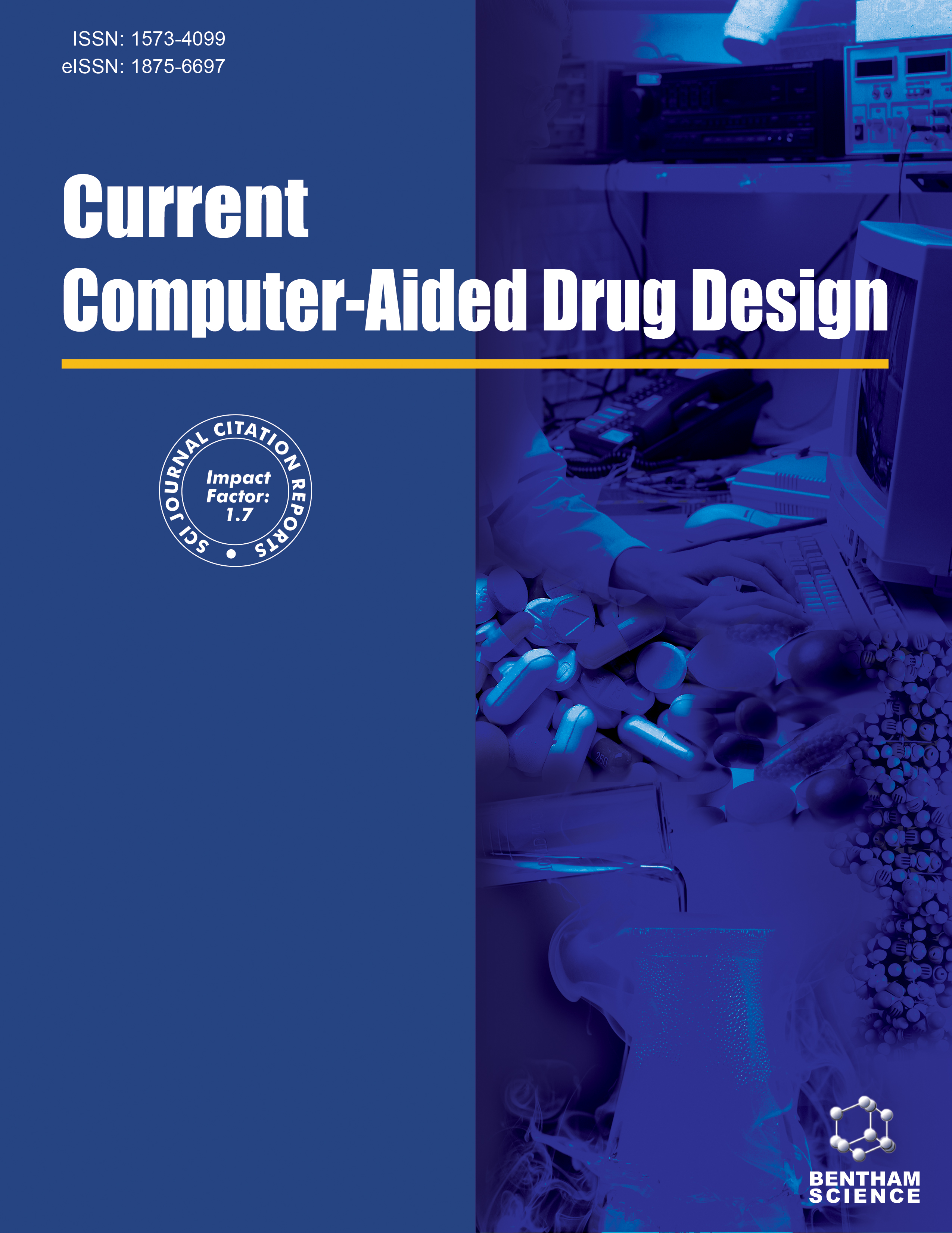- Home
- A-Z Publications
- Current Computer - Aided Drug Design
- Previous Issues
- Volume 14, Issue 3, 2018
Current Computer - Aided Drug Design - Volume 14, Issue 3, 2018
Volume 14, Issue 3, 2018
-
-
Molecular Modeling Studies on Some Important Anticancer Heterocycles: An Overview
More LessAuthors: Mayura Kale, Gajanan Sonwane, Rajesh Nawale and Vishnukant MouryaThere has been a rapid surge in the research and exchange of ideas in various areas of chemistry such as organic, pharmaceutical, analytical, and medicinal chemistry. It is well recognized that heterocycles are vital components of many biochemical processes. Pharma industry comprises more than 75% of top selling drugs that are of heterocyclic origin. Among many diseases, cancer can be considered to be a dreaded disease t Read More
-
-
-
Computational Study of Imidazolylporphyrin Derivatives as a Radiopharmaceutical Ligand for Melanoma
More LessBackground: Melanoma is the most aggressive type of skin cancer. Metastatic melanoma is extremely difficult to treat with current therapy methods such as surgery. On the other hand, it is a good opportunity to develop a radiopharmaceutical using a radionuclide such as Technetium (Tc) for diagnostic and Rhenium (Re) for therapeutic purposes. T3,4BCPP has been be used as a radioimaging agent for melanoma canc Read More
-
-
-
Identification of N-Benzylated Indole Mannich Bases as Potential Anti TB Agents by Using Computational Studies and Molecular Hybridization Technique
More LessIntroduction: Morbidity and mortality due to tuberculosis are rising steadily. Despite having efficient drugs and treatment protocols, microbial drug resistance often leads to treatment failure. Efforts to bring novel drugs to combat this menace are hampered by several issues including problems in gaining industry support, motivation and ethical issues clinical trials. Bedaquiline and Delaminid are the only novel drugs approved in t Read More
-
-
-
4D-QSAR Studies Using a New Descriptor of the Klopman Index: Antibacterial Activities of Sulfone Derivatives Containing 1, 3, 4-Oxadiazole Moiety Based on MCET Model
More LessAuthors: Yahya Guzel, Ertugrul Aslan, Burcin Turkmenoglu and Ekrem M. SuIntroduction: In this paper, we have introduced a new atomic descriptor with Klopman index to determine the local reactive sites of the molecular systems during electrophilic, and nucleophilic attacks. This index, similar to other local reactivity descriptors but more advanced, has been used as a realistic descriptor to discover new aspects of molecular structure. Methods: Nonlinear Least Squares (NLLS) methods to define the pa Read More
-
-
-
Rational Discovery of Novel Squalene Synthase Inhibitors through Pharmacophore Modelling
More LessAuthors: Avani B. Chokshi, Mahesh T. Chhabria and Pritesh R. DesaiIntroduction: In the present research work, a pharmacophore based virtual screening was performed using Discovery Studio 2.1 for the discovery of some novel molecules as inhibitors of Squalene Synthase Enzyme, a key enzyme in cholesterol biosynthetic pathway. Methods: A quantitative pharmacophore HypoGen was generated and the best HypoGen had two ring aromatic and one hydrogen bond acceptor lipid features. Read More
-
-
-
Molecular Docking and Dynamic Simulation Studies of Terpenoids of I. wightii (Bentham) H. Hara against Acetylcholinesterase and Histone Deacetylase3 Receptors
More LessBackground: Genus Isodon (Lamiaceae) is a prolific source for bioactive terpenoids. Nowadays, people move towards natural products because of undesirable effects of chemotherapeutic drugs. Objective: In silico and in vitro approaches were attempted to screen bioactive terpenoids isolated from Isodon wightii with acetylcholinesterase and histone deacetylase3 receptors. Methods: Terpenoids such as abietic acid, oleanolic ac Read More
-
-
-
Molecular Modeling, Docking, Dynamics and Simulation of Gefitinib and its Derivatives with EGFR in Non-small Cell Lung Cancer
More LessBackground: Gefitinib (lressa) is the most prescribed drug, highly effective to treat nonsmall cell lung cancer; primarily it was considered that targeted therapy is a kinase inhibitor. The nonsmall cell lung cancer is caused by mutation in the Epithelial Growth Factor Receptor (EGFR) gene. Iressa works by blocking the EGFR protein that helps the cancer cell growth. EGFR protein has lead to the development of anticancer the Read More
-
-
-
Identification of Inhibitors for the Lutheran Blood Group Glycoprotein – Laminin 511/521 Interaction by Molecular Modelling and Simulation Techniques
More LessAuthors: Noelly Madeleine and Fabrice GardebienBackground: Drepanocytosis is a genetic blood disorder characterized by red blood cells that assume an abnormal, rigid, sickle shape. In the pathogenesis of vaso-occlusive crises of sickle cell disease, red blood cells bind to the endothelium and promote vaso-occlusion. At the surface of these sickle red blood cells, the overexpressed protein Lutheran strongly interacts with the Laminin 511/521. The aim of this study is to i Read More
-
Volumes & issues
-
Volume 21 (2025)
-
Volume 20 (2024)
-
Volume 19 (2023)
-
Volume 18 (2022)
-
Volume 17 (2021)
-
Volume 16 (2020)
-
Volume 15 (2019)
-
Volume 14 (2018)
-
Volume 13 (2017)
-
Volume 12 (2016)
-
Volume 11 (2015)
-
Volume 10 (2014)
-
Volume 9 (2013)
-
Volume 8 (2012)
-
Volume 7 (2011)
-
Volume 6 (2010)
-
Volume 5 (2009)
-
Volume 4 (2008)
-
Volume 3 (2007)
-
Volume 2 (2006)
-
Volume 1 (2005)
Most Read This Month
Article
content/journals/cad
Journal
10
5
false
en


